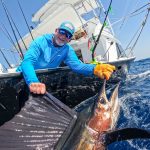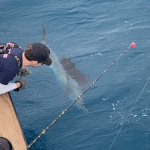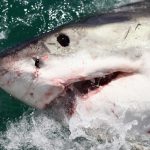ROFFS™ Fishy Times Newsletter – 85th Edition – Updated Videos/Catch Reports, Gulf of Mexico Dead Zone & Mid-Atlantic $500,000
NEWS
Updated Videos on ROFFS™.com – Be Sure to Check Out the “Hot News” Button on the ROFFS™ Homepage
Big Oh’s 1254 Lb. Blue Marlin!

1254lb Blue Marlin caught on July 3, 2015 in Cape Verde, Africa aboard BIG OH. Owner/Angler Gray Ingram fought this blue marlin for over 5 hours, caught on a pitch bait, his first grander ever. It became the 9th largest blue marlin ever caught in the Atlantic Ocean. This the first and only fish, of over 1,000 blue marlin tagged & released, to be killed aboard Big Oh. Big Thanks to Brad Phillips for his help. Video Courtesy: Camila Hidalgo | Vimeo
Please click HERE to watch the video on our website now!
Stingrays Swarm!

Stingrays Swarm! Video Courtesy: Oceanwire Blog | YouTube
Please click HERE to watch the video on our website now!
Giant Trevally Lightning Attack!

These Giant Trevally make a lightning fast attack on bait by the shore. Video Courtesy: AFTCO | Facebook
Please click HERE to watch the video on our website now!
Incredible Man-Powered Hydrofoil!

Incredible man-powered hydrofoil! Video Courtesy: VideoBash Fan Page | Facebook
Please click HERE to watch the video on our website now!
Heavy Seas!

Who says an Aircraft Carrier wont rock and roll!!! Video Courtesy: Charles Hudson | Facebook
Please click HERE to watch the video on our website now!
2015 Gulf of Mexico Dead Zone ‘Above Average’
Article Courtesy: ecomagazine.com | Originally published Aug 2015
Scientists have found this year’s Gulf of Mexico dead zone — an area of low to no oxygen that can kill fish and marine life — is, at 6,474 square miles, above average in size and larger than forecast by NOAA in June. The larger than expected forecast was caused by heavy June rains throughout the Mississippi River watershed.
The measured size this year — an area about the size of Connecticut and Rhode Island combined — is larger than the 5,052 square miles measured last year, indicating that nutrients from the Mississippi River watershed are continuing to affect the nation’s coastal resources and habitats in the Gulf. The size is larger than the Gulf of Mexico / Mississippi River Watershed Nutrient Task Force (Hypoxia Task Force) target of 1,900 square miles.
“Dead zones,” also called hypoxia areas, are caused by nutrient runoff from agricultural and other human activities in the watershed and are highly affected by river discharge and nitrogen loads. These nutrients stimulate an overgrowth of algae that sinks, decomposes, and consumes the oxygen needed to support life in the Gulf. Dead zones are a major water quality issue with an estimated total of more than 550 occurring annually worldwide. The Gulf of Mexico dead zone is the second largest human-caused hypoxic area in the world.

Above: Image caption: Distribution of bottom-water dissolved oxygen from July 28 to August 3, west of the Mississippi River delta. Black lined areas — areas in red to deep red — have very little dissolved oxygen. Data: Nancy Rabalais, LUMCON; R Eugene Turner, LSU. Map credit: NOAA.
Please click here to read more on the dead zone in the Gulf of Mexico on our website now!
ROFFS™ Regional Special Analysis – 2015 Mid-Atlantic $500,000
We are providing an update today as the skies are clear and the conditions warrant the larger area update. We are using today infrared (sea surface temperature) and yesterday’s ocean color. The ocean color imagery was derived from two different satellites and allows us to provide a more complete image of the entire area at one time as clouds moved over the southern canyons, south of the Baltimore Canyon this afternoon.
The Gulf Stream is oriented more northeastward after turning northward toward the Norfolk Canyon over the last few days. During the last few days including today a new supply of Gulf Stream water and presumably fish have entered the Norfolk Canyon and Washington Canyon areas. As the meander in the Gulf Stream moves eastward the Gulf Stream effectively is moving away from the Norfolk Canyon and the eastward pull of the water has resulted in the Washington Canyon eddy to move more southward. It remains to be seen over the next 5-10 days whether the eddy will continue move eastward and absorbed by the Gulf Stream or drift southward to be absorbed by the Gulf Stream east of the Virginia – North Carolina border. The important concept is that new Gulf Stream water and presumably fish is likely to enhances one’s chances for fishing action over the Norfolk Canyon in particular. The offshore pull by the eddy is likely to result in a substantial decline in the fishing action over the Washington Canyon after tomorrow as the greener coastal water will be pulled over the canyon.

Don’t Forget to Send Us Your Fishing Reports for our Weekly Catch Reports!

Above: Excellent work Tyler and team!!! Congratulations Capt. Tyler Andersen and crew, pending new Massachusetts state record blue marlin. Glad we could help as part of your team.
Please click here to view the most recent catch reports on our website now!
Backlash? Feedback?
As always, please send comments & feedback on Fishy Times newsletter content directly to us at feedback@roffs.com.

If you do not want to wait for our next Fishy Times newsletter, please visit us in the meantime to get all your fishing news on Facebook, Instagram, Twitter, YouTube and on the web. Safe and successful fishing until next time!






